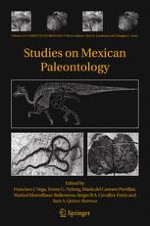
2006 | OriginalPaper | Buchkapitel
Geological setting and phytodiversity in Mexico
verfasst von : Sergio R. S. Cevallos-Ferriz, Enrique A. Gonzàlez-Torres
Erschienen in: Studies on Mexican Paleontology
Verlag: Springer Netherlands
Aktivieren Sie unsere intelligente Suche, um passende Fachinhalte oder Patente zu finden.
Wählen Sie Textabschnitte aus um mit Künstlicher Intelligenz passenden Patente zu finden. powered by
Markieren Sie Textabschnitte, um KI-gestützt weitere passende Inhalte zu finden. powered by
The joint discussion of biotic and abiotic factors allows proposal of a hypothesis in which the dynamic nature of the geological processes and of the organisms facilitate the understanding of the biodiversity of Mexico. In this respect, we highlight that since the Cretaceous, Mexico had a configuration similar to that of a peninsula that increased in size through time, but that with the establishment of the Isthmus of Panama approximately 3.5 my ago, it no longer had such a configuration. During this peninsular configuration, the main mountain belts of Mexico formed in different episodes of time attaining variable sizes through dynamic and fluctuant processes until they reached their extant physiognomy. At the same time the retreat of the seas was significant in exposing positive zones of the continent, where life was established. Finally, after occupying their current positions, the Baja California Peninsula and the Yucatan Peninsula started providing cover to the central continental mass of Mexico. The fossil record suggests that while all of this occurred, the newly generated environments were occupied by plants that were formerly part of higher latitude communities of North America. That through the land bridges that connected North America with Europe and Asia, plants with different geographical affinities arrived in Mexico. Also with the establishment of the Chords Block as the northern part of Central America, at least part of the plants already growing on the Chortis Block arrived into the rest of Central America eventually expanding their distribution into South America. The interaction of the biological processes, as suggested by the fossil record with the environment, coupled with the geological setting, promoted the development and establishment of a distinctive biota among which, the endemic plants that characterize today the vegetation of Mexico stand out.Some of the extant Mexican plants were already present in the Oligocene and possibly since the Eocene. Finally, the current landscape and the elements that conform it began their “modernization” some 3.5 million years ago, but they may have a longer history that started in the Cretaceous.